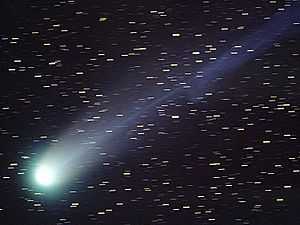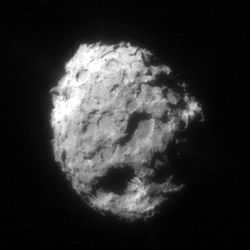68P/Klemola
| Discovery | |
|---|---|
| Discovered by | Arnold Richard Klemola |
| Discovery date | November 1965 |
| Alternative designations | 1965j 1965 VI, 1976j, 1976 X, 1987th, 1987th XIV |
| Orbital characteristics A | |
| Aphelion | 8.032 AU |
| Perihelion | 1.755 AU[1] |
| Semi-major axis | 4.896 AU |
| Eccentricity | 0.6407 |
| Orbital period | 10.82 a[2] |
| Inclination | 11.1°[2] |
| Last perihelion | January 20, 2009 |
| Next perihelion | November 9, 2019[3][4] |
68P/Klemola or Klemola's Comet is a periodic comet, which belongs to Jupiter's comet family, that was discovered in 1965 by American astronomer Arnold Richard Klemola in Argentinian Yale-Columbia Southern Station.[2] Its orbital period is 10.82 years.[2]
It was observed at the next predicted apparition by Gérard Sause at the Observatoire de Haute Provence, France on 6 August 1976 with a brightness of magnitude 12. It was successfully observed in 1987 when J. Gibson of the Palomar Observatory, California, obtained images with the 1.5-meter reflector on 16 February. It appeared essentially stellar, with a faint magnitude of 19. It was observed again in 29 March 1997 by Carl W. Hergenrother at the F. L. Whipple Observatory, with perihelion on 1 May 1998.
See also
References
- ↑ Fernández, Julio Angel (2005), Comets: nature, dynamics, origin, and their cosmogonical relevance, Springer Science & Business, p. 344, ISBN 1-4020-3490-3
- ↑ 2.0 2.1 2.2 2.3 Zombeck, Martin V. (2007), Handbook of space astronomy and astrophysics (3rd ed.), Cambridge University Press, p. 61, ISBN 978-0-521-78242-5
- ↑ Seiichi Yoshida (2010-07-03). "68P/Klemola". Seiichi Yoshida's Comet Catalog. Retrieved 2012-02-18.
- ↑ Patrick Rocher (January 15, 2010). "Note number : 0023 P/Klemola : 68P". Institut de mécanique céleste et de calcul des éphémérides. Retrieved 2012-02-19.
External links
- Orbital simulation from JPL (Java) / Horizons Ephemeris
- 68P/Klemola in Cometography
| Periodic comets (by number) | ||
|---|---|---|
| Previous 67P/Churyumov-Gerasimenko |
68P/Klemola | Next 69P/Taylor |

